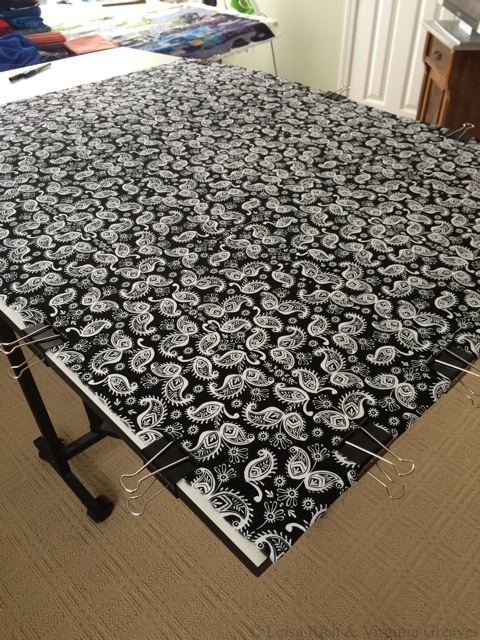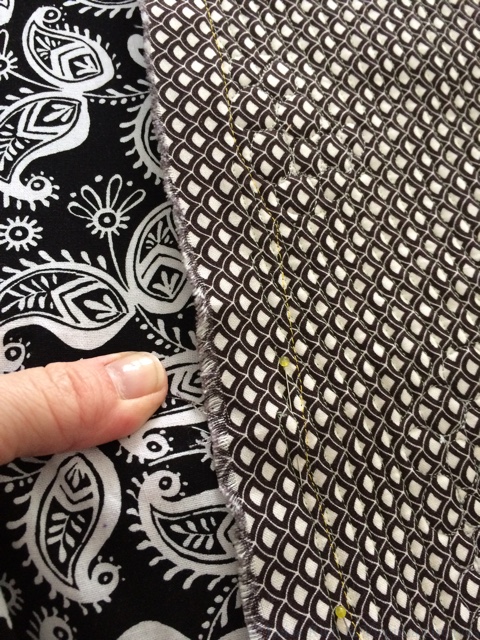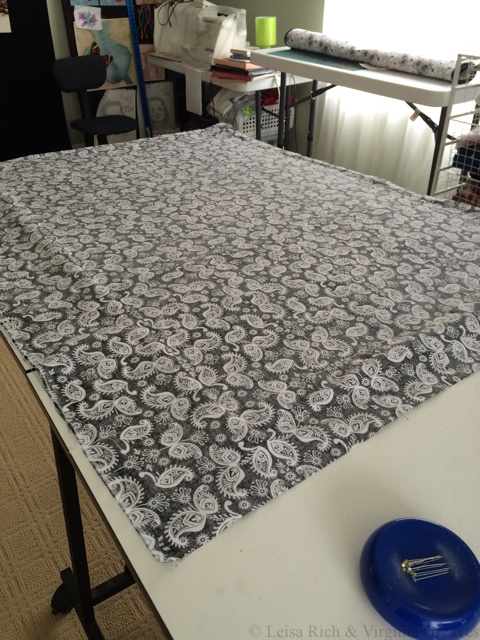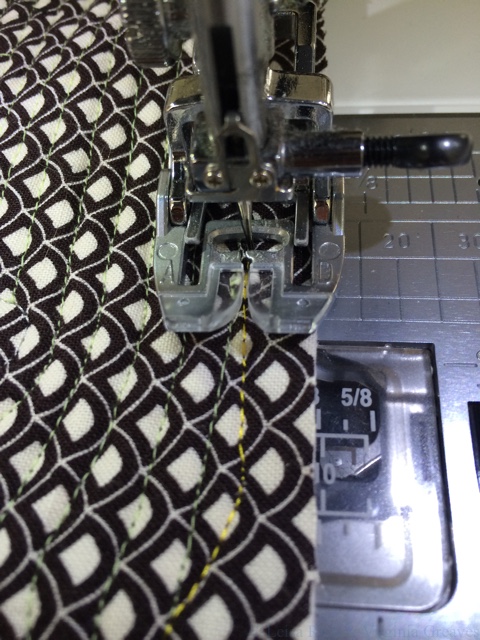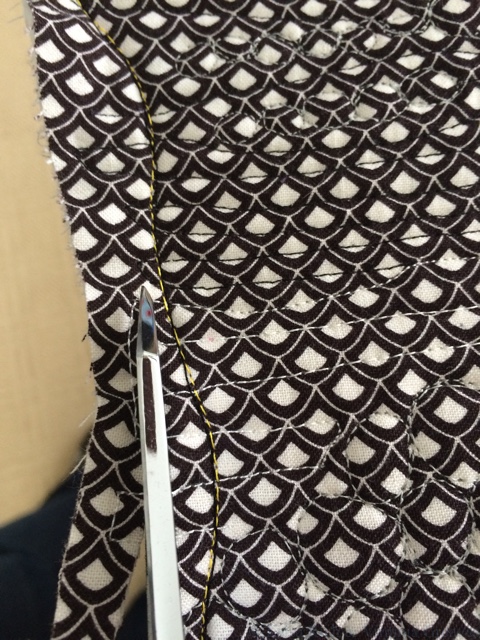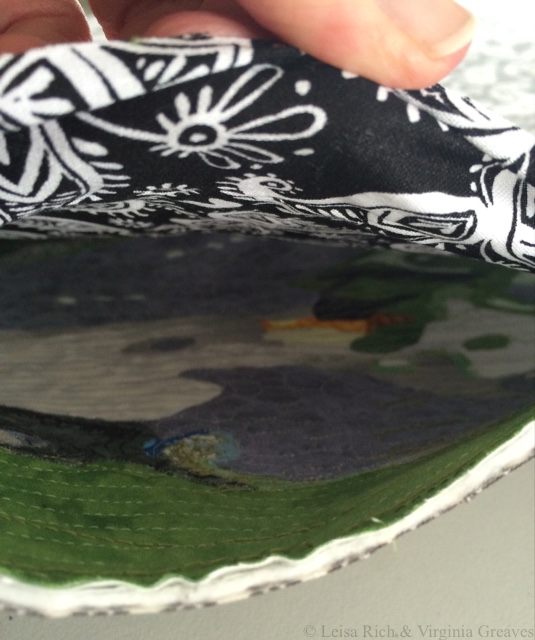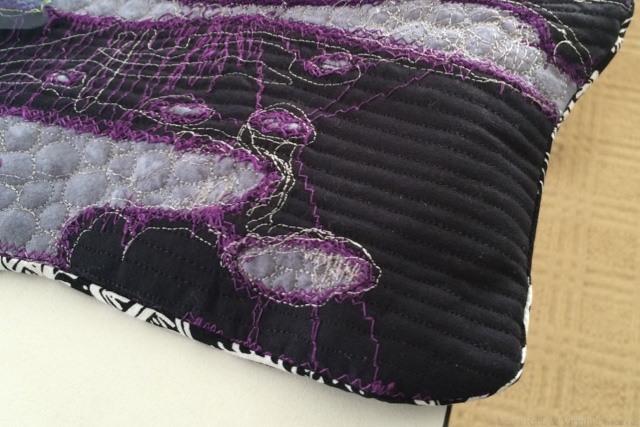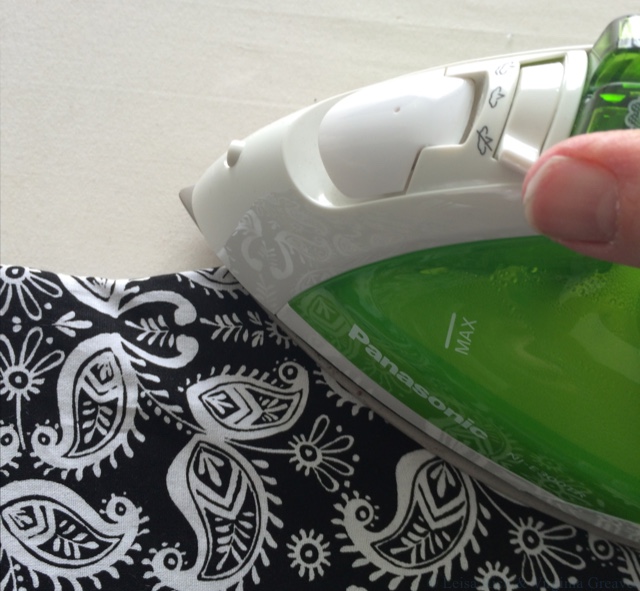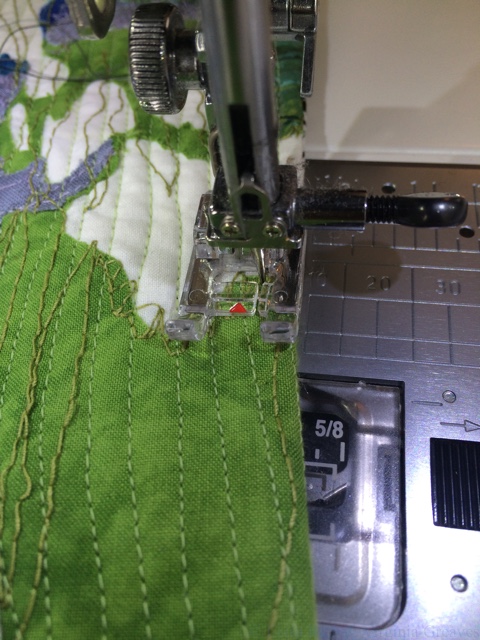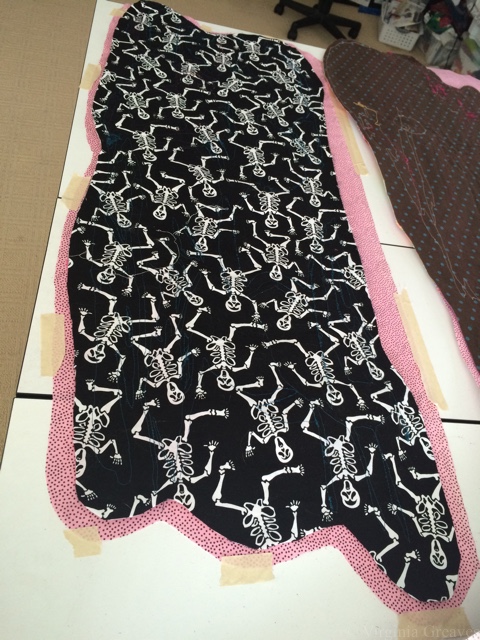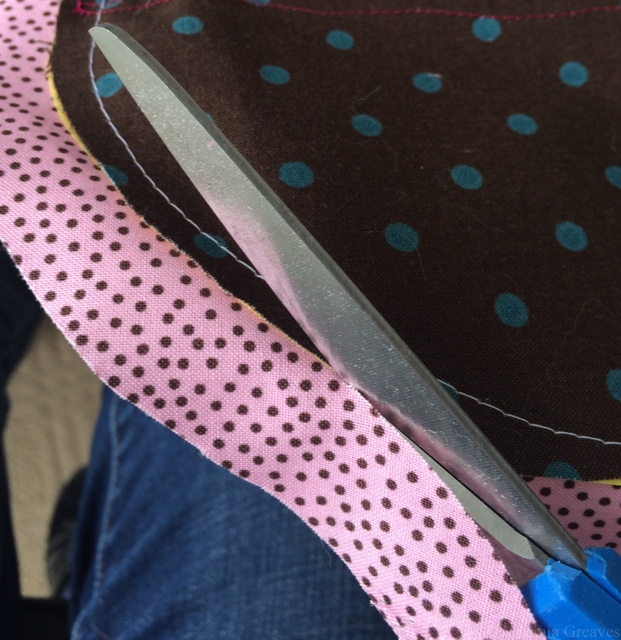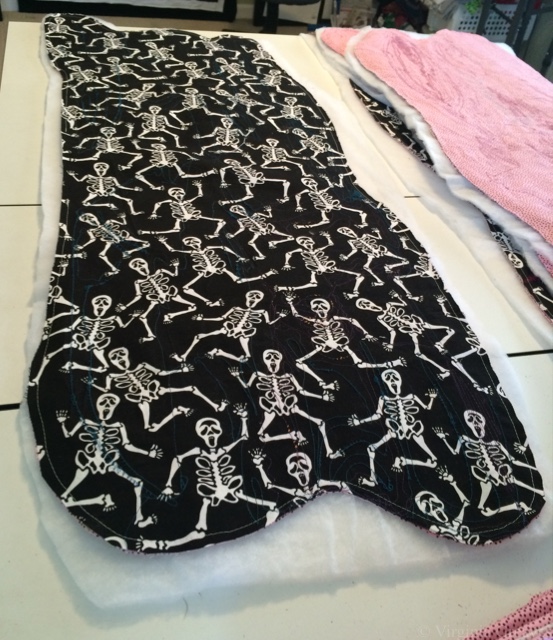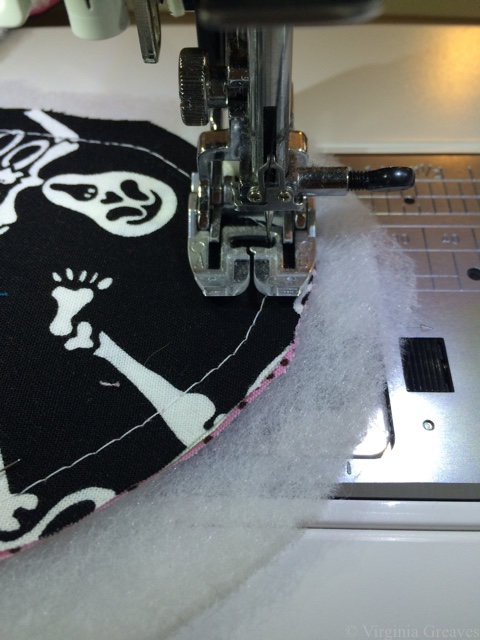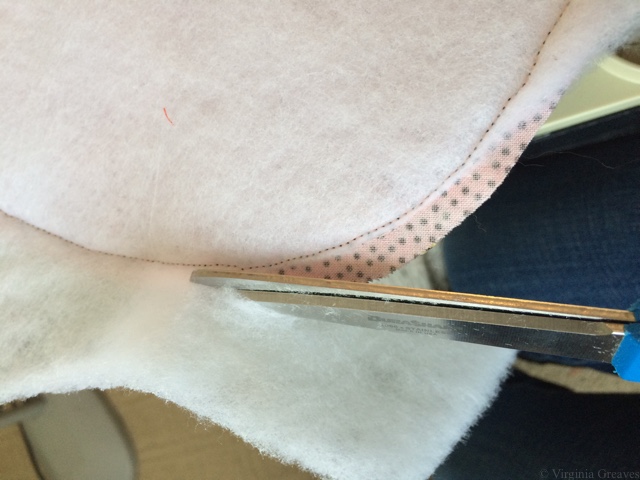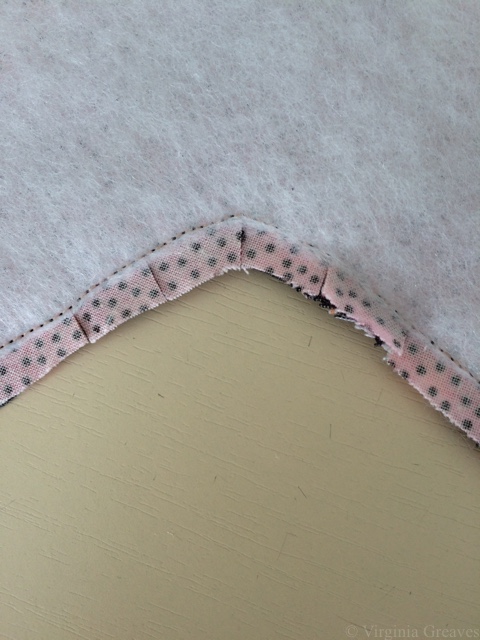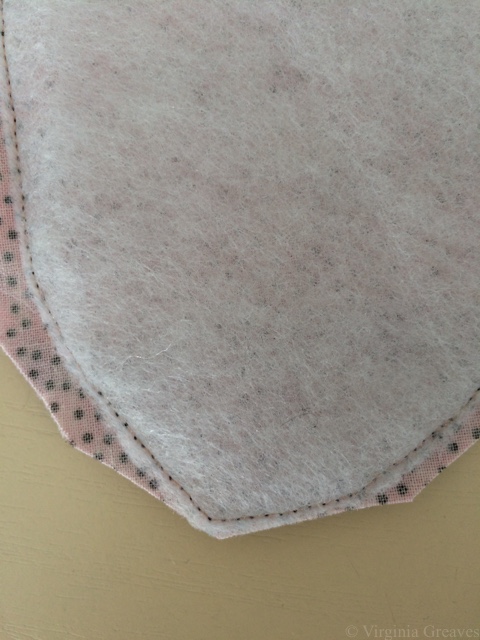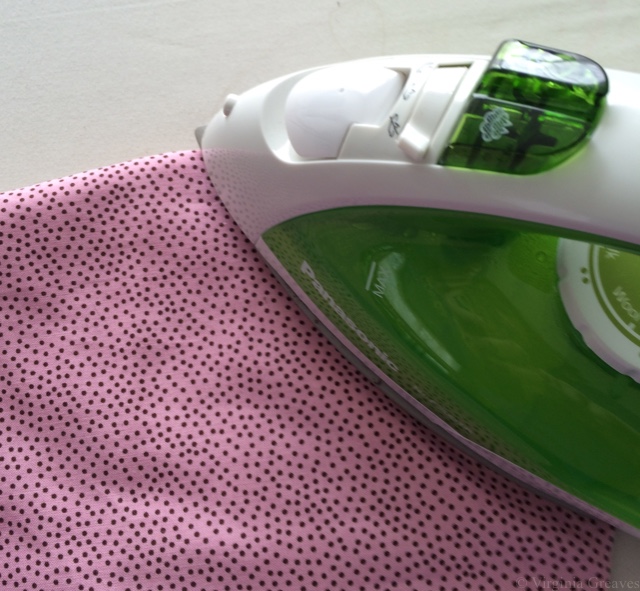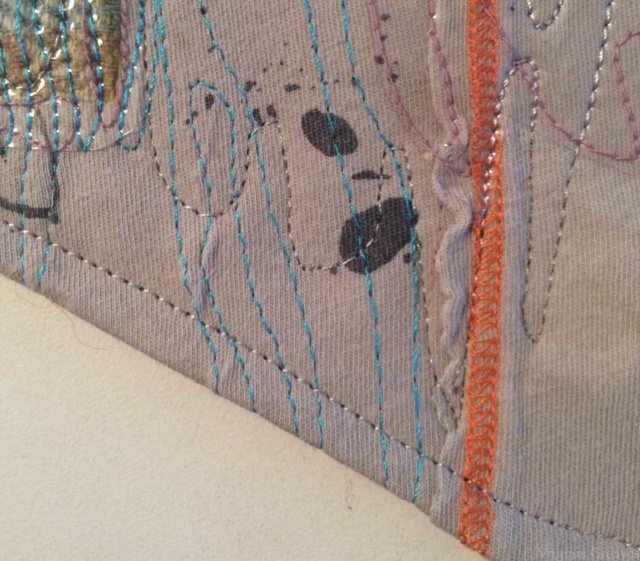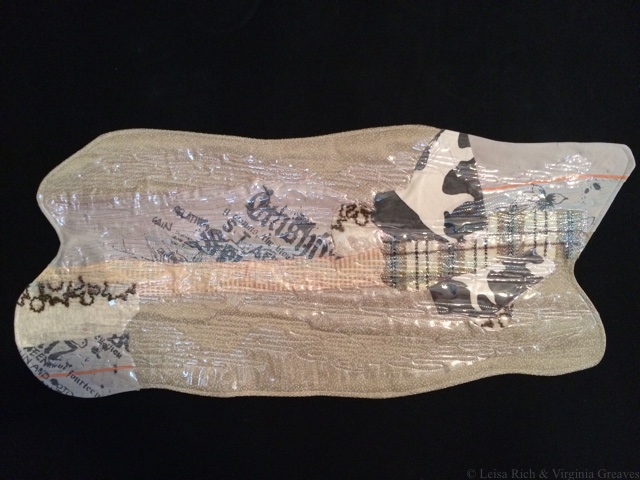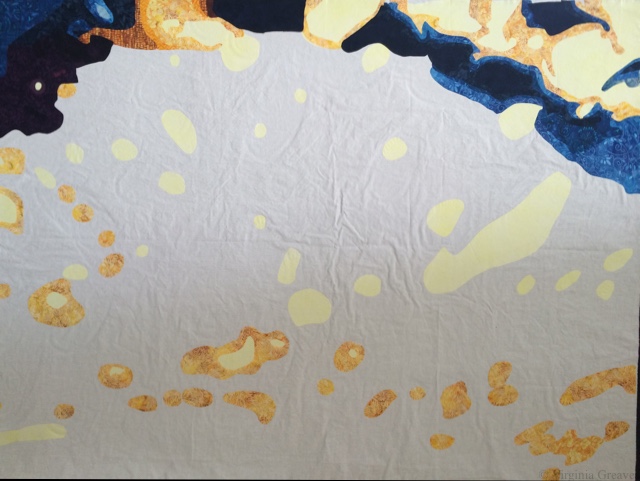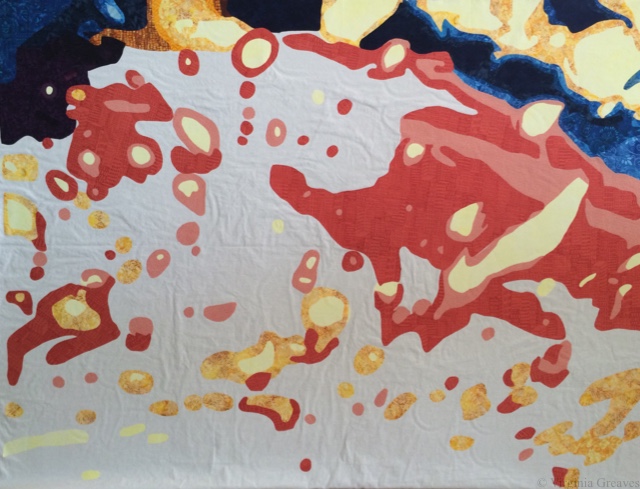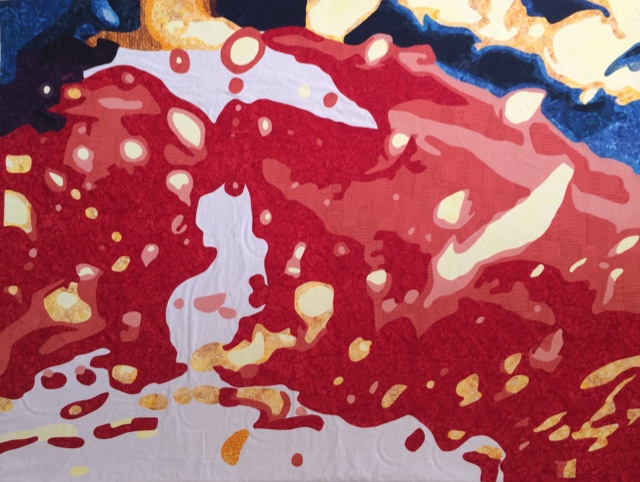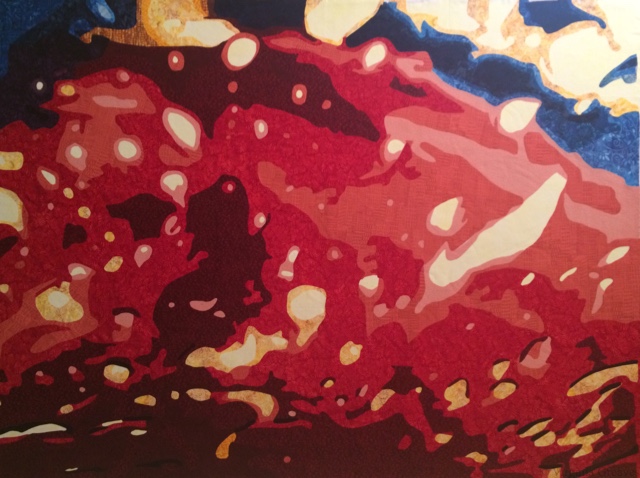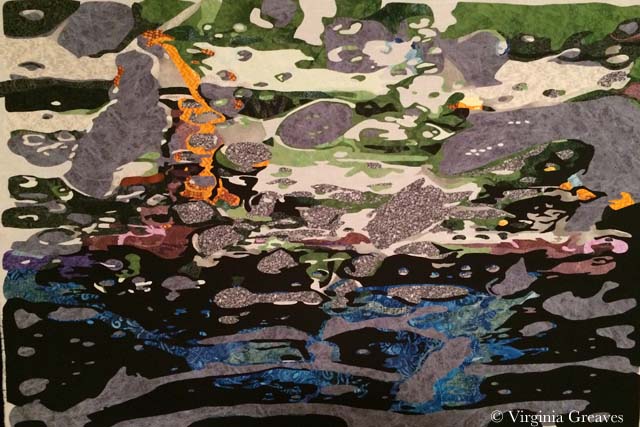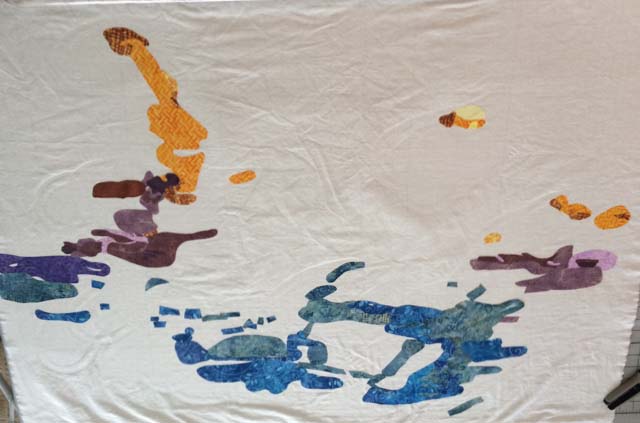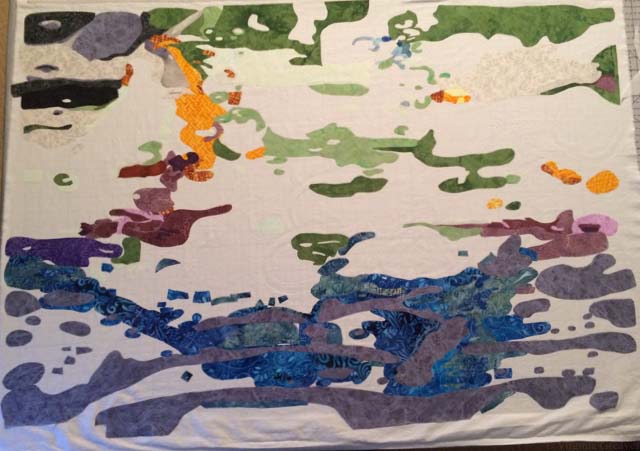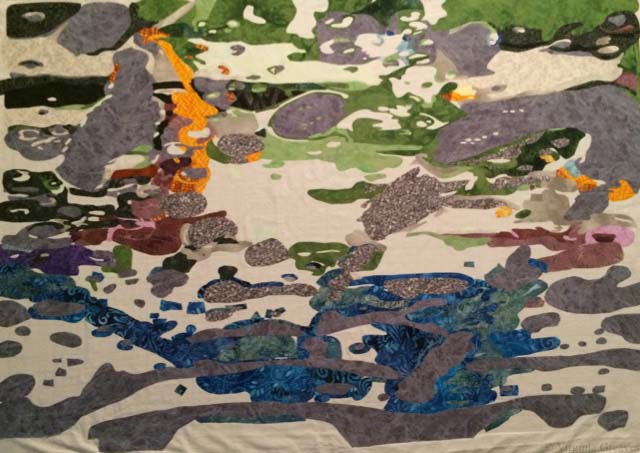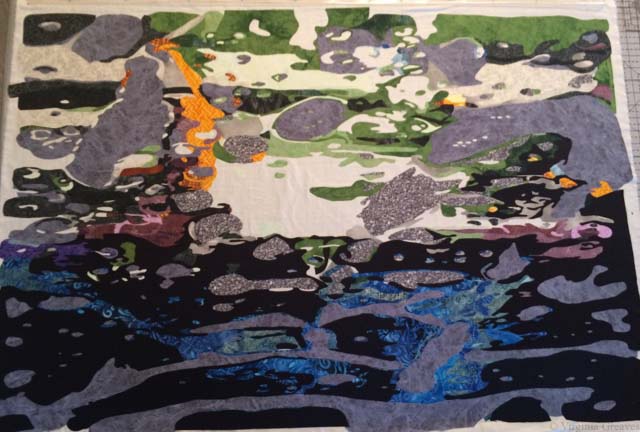
Home Stretch
0I haven’t been very motivated to write much recently, but I have been getting a lot of studio time in. I think I’m just growing weary. Preparing for a big two-person show like this has been interesting — and a lot of work. At this point, everything is fairly planned, & it’s the execution that remains.
I finished quilting #5 — the really big one.  So glad I bought a big cone of red thread for this. I love the trapunto I put in all the yellow areas, but now I’m debating how to finish off the edges. I had planned on facing it, but I’m not sure how that would work with so many layers of batting along the top edge. I might use a red and blue binding, although that would mean yet another trip to the fabric store since my last 2 pieces took all my good red & blue fabric pieces & reduced them to scraps. For now, I’ve put it aside. Leisa wants to add some handwork, so I’ll pass it back to her.
So glad I bought a big cone of red thread for this. I love the trapunto I put in all the yellow areas, but now I’m debating how to finish off the edges. I had planned on facing it, but I’m not sure how that would work with so many layers of batting along the top edge. I might use a red and blue binding, although that would mean yet another trip to the fabric store since my last 2 pieces took all my good red & blue fabric pieces & reduced them to scraps. For now, I’ve put it aside. Leisa wants to add some handwork, so I’ll pass it back to her.
I picked up #6 yesterday & started quilting it. I had to take off all the strips Leisa had pinned on there. I numbered them & took pics — I even made some marks with my erasable white pen (though it’s almost empty & I can’t see most of the marks now). Not sure if I can get them in exactly the same place, but I’ll do my best. Figured they could wait until after its quilted — maybe even bound (or faced).
And then I’ve started planning out one that I’ll cut into a smaller pieces to be framed. It’s still in draft mode, but it’s been started.
After that, other than the pieces for the big wall installation — & another big installation piece that Leisa’s planning for the middle — there’s one left. I’ll call it #7. (I promise to give them better names eventually.) I think that I’ll have it printed from a manipulated digital image directly on to the fabric rather than another appliqué piece. Maybe 3 panels. Different from the others.
Home stretch.

The View From Above
0Sometimes it’s a good thing to change your perspective.

Today is warm and the breeze is lovely. I’m sitting on the deck, basking in the sun.
I’ve been thinking about my series that I’ve been working on with Leisa. I have 2 that I’m quilting now, and then 2 last ones planned. But I have an idea for a new series brewing in my head. I know that having done this abstract series will change my work. It’ll be interesting to see what comes. I certainly have changed my planning as well as some of my methods, but I do still want to work in portraiture — but faster, with pieces that build on each other. A thread, working through each consecutive piece and holding them together.

I spy . . . With my little eye. It’s really all about perspective, isn’t it?
Sunday Morning Reading
1One of my favorite things to do on a Sunday morning is to curl up on my couch and read the blogs of other artists. This morning, there’s not much in the queue. I opened up Feedly, and my only options are the ever prolific Hyperallergic and 99U.
Then I felt a stab of regret. I’ve been writing less and less on my blog, some of which is for personal reasons. But can I complain when my fellow artists aren’t producing content to keep me sufficiently entertained?
I’m sure there’s less to read for another reason. After the debacle on the QuiltArt list in November, I took several blogs off my reading list. I also took them off my FaceBook friends list. I’m sure they didn’t even realize I was there. (Which is an unfortunate glimpse into the impersonal side of FaceBook, isn’t it?) I knew only too well who my bullies were — I had been reading their blogs.
But I made a decision. One that I think each of us needs to make. Am I going to serve the light or the dark? My own situation aside, I’ve seen online bullying sprouting like Spring weeds on the Internet. It’s almost as if people feel that they can share what ever horrible thought that springs into their heads.
We all have our opinions, but as artists, we should support each other. There is not only one pie that we fight over — we make a bigger pie. And I choose to help other artists. I don’t have time for trolls. When I see them, I no longer look away — I confront them & tell them there is a better way. We can’t tolerate the behavior of bullies. We tell kids not to do it. Adults shouldn’t do it either.
Ranting aside, I have less to read. If you have any blogs to recommend of artists that share their creativity and positive energy with the world, please share.

Abstract #6 Cut
0You may not realize it, but I work on deadlines — by the ones laid out by exhibitions and shows and the ones I set for myself. I have a calendar that I mark with all important dates for shows I’m interested in entering. If I’m not diligent in keeping track, I would be guilty of promising a piece of work at more than one place at the same time, and because I’m a professional, I work hard to make sure that doesn’t happen.
However, at least twice in the past year, I’ve had shows that I’ve entered change their dates mid-stream. I’ve entered the show knowing that I’ll have until X date to be notified as to whether it will be included or not in the show, and after that date, if it isn’t accepted, I can enter it somewhere else.
Friday, I spent the afternoon looking at my inbox. Finally, at 5 o’clock, I went to the website for the show and found that they had changed their notification date. Today (4 days later), I received an email with an apology and announcement of the new notification date. <sigh> <shakes head> This show was a long shot for me, and quite frankly, I had another show I was going to enter it into, but now I can’t do that. I suppose if I win the lottery and get in, I won’t mind a bit, but chances are good that notification day will be a bit more bitter than if they had just given notification on time. <grumble grumble>
I have been cruising through #6 in the abstract series. This collaboration with Leisa Rich is called Wash & Wax and will premiere at The Abernathy Arts Center in Sandy Springs this coming September.
We met a couple of weeks ago and planned on it having the appliqué in one section and embellishment after quilting from Leisa in another section that would overlap mine.
The majority of the appliqué is red. I started with a new fabric for the first value, something peachy pink, a little hard to find in my local quilt shop. (It’s hard to find a pink that will work as a first value for red without screaming PINK.)

I then used up the secondary red color from #5 as my secondary value here as well. I planned out all of the pieces on my remaining fabric, and after it was all fused down, I found two pieces that didn’t make it to the ironing board, and I didn’t have enough of the building print to accommodate them. Rather than panic, I found a solid hand-dyed fabric that I had made several years ago. It isn’t textured, but it makes a decent substitution. Once all of the other fabrics are on there, I don’t think it’ll be noticeable at all.

The third value is also from #5, and I used up almost all of it. I only have a few very small scraps left.

I changed my fourth value for this one. I didn’t think that there was enough contrast between the red pinecones and the 5th value in #5, so this time, I found a red print of wings in my stash that’s been there at least 10 years. I like the movement it adds here.

And my fifth value is the same as what I used in #5, but it shows up better with the wing fabric.
I hope it’s obvious by now that this piece is less about color interpreted through water and more about the machinery that washes the car with strips of fabric. I have done all of the red in appliqué. The majority of the blue will be embellishment attached to the top after it’s quilted.

There’s a little yellow in the corner to show where the light is coming from.

And then this is a blotch of blue where all of the blue embellishment will go. I just wanted to put a dark fabric here that would be a background for the strips put on top, a better choice than the white.

I’m meeting with Leisa again later this week. She’s done embroidering #5 so I can start quilting it, and I’ll give her #6 to start on. If you remember, #5 is very large — 60″ x 48″ — so I suspect quilting it will be a bear. I had to order more batting for it.
Right now I’m quilting some of the smaller pieces for the wall installation piece. So much to do — so little time.

Special Finish for Irregular Shapes
0I met with Leisa last week about finishing Abstract #4, and she wanted it to have completely irregular edges. It sounds completely simple, but if you know anything about binding a quilt, it’s really not. I considered a facing, and I’ve begun to really like the look of a faced quilt from the front since there is no distraction of any binding, but facing it would still mean having to join strips at some point, and if none of the points were square, joining them on the bias would be a nightmare.
I briefly considered a bias binding.
After discussion of this dilemma, Leisa suggested that I finish it with a false back. I would have to add some more quilting afterwards, but the end result would be a faced irregular edge without worrying about binding or facing strips. It would be similar to what I’ve been doing on the free-form pieces, so I decided to give it a try on a larger scale. The only difference is that this piece is all ready quilted. I would have to add some more quilting at the end.
First thing, and sadly I don’t have a picture of this, I took a few markers and drew curves on the quilt to indicate where I wanted the boundaries to be. Then I took a top black thread and a bright yellow bobbin thread (that I would be able to easily follow on the black & white fabric on the currently quilted back) — and I sewed on the drawn line. I would use this as a guide later.
I took my false backing fabric and stretched it flat on a table with the front side up.
I then layered the quilt face side down on top of the false back — right sides facing each other — and then pinned them. I pulled a little on the fabric as I went to make it as taut as possible.
When I flipped it over, it was taut enough I think I could have flipped a penny on it.
I flipped it back over so that the false back was facing down and the quilted back was facing me — and stitched a line over the yellow guide line I had sewn earlier. I did find a section that was relatively straight, about a hand’s width, and left that section un-sewn so I could use that space to turn it right-side out later.
Using sharp scissors, I cut a 1/4″ from the sewn line to remove excess fabric.
I clipped my inside corners to the sewn line (but not through), and I shaved some of the seam allowance from the outside corners.
And then all that was left was to turn it right side out.
Once turned right side out, I carefully poked out the outside corners and smoothed the edges. It still looks like a pillowcase at this point.
But I turned it over and from the back, I steamed the edges into submission.
I did press down the seam allowances in the section that was un-sewn and pinned them. I’ve learned from experience that it’s a good idea at this point to check that there’s not excess fabric across the middle, and if there is, smooth it towards this un-sewn section, re-fold the seam allowance to pull in that excess fabric, and re-pin. The goal is to make the back as taut as possible.
When I was done, I picked a neutral thread, something that I thought would blend well across all of the fabrics on the front (for me, a charcoal), and topstitched the edge about a quarter inch from the edge.
The result is a very flat piece with irregular edges. I did go back and quilt on it for a couple more hours, ditch stitching around the major shapes, and I liked the added dimension that that gave the piece. In the end, I didn’t save any time from adding a binding, but my fingers were happy to not do the hand sewing, and the result is a very well done irregular faced edge. (I did have to hand sew the sleeve to the back at the end.)
I could have, by the way, done this in the beginning with my first back before I started quilting, but given how tightly I quilt my pieces and how large this piece is, I felt that there would be tucks on the back. When you quilt tightly across the grain, fabric stretches, and it’s nice to be able to smooth that out to the ends and off the edges if you need to. With this technique, I wouldn’t have had that opportunity — the pulled fabric would have been trapped at the faced edge. It would have saved me the second quilting time though. Something to consider next time.
But now she’s done. She’ll debut in our two-person show at The Abernathy Art Center in Sandy Springs, GA, in September/October.
I have a page for Abstract #4 here — but the final pictures won’t be debuted on the website until after opening night in the gallery.

Studio Furniture
0Everyone dreams of having the perfect studio. Lots of room — lots of light — and wide tables. For our sewing machines, we want an inset for the machine with acrylic around the base, and hopefully space to the left and back of the machine to bear the weight of what we are working on.
I set up my first “studio” in the guest room. When I bought my first machine, a Viking — Lilly, I think — I also bought a Koala Cub to hold it in. When a guest would come, I could use the hydraulic lift to lower it into the cabinet and close the lid. For what it cost, I had aspirations for it to last a lifetime. It wasn’t the largest, but it’s what I could afford at the time.
As I began to take over the guest room and realize that it was truly my studio — because really, why keep a guest room when you only have a guest once or twice a year? — I added a few pieces. When my girls had outgrown the changing table, I hauled it in and used it for open shelving. I took an old bookcase and loaded it with books and binders of notes. I even bought a cool craft table from Hancock’s with 2 leaves that fold up.
That craft table. I’ve loved it to death — literally. It’s on its last legs. It’s great because I can fold up the two sides and roll it into a corner when I want to convert the studio to a guest room — on the few occasions a year that company comes.
The final size is just shy of 36″ x 60″ when fully extended. But wait, isn’t that a screw down there underneath? Yes, several screws can no longer be seated. The table is no longer flat — you can see the top on the right-hand side bends a little lower than the rest — and there’s quite a lean to the entire thing. I think it may fall over soon.
It’s a perfect size because I can place a 36″ wide cutting mat on one end, and it even has an ironing cover I can put on it when I want to iron something bigger than my ironing board.
Looking around the internet, it looks like the best solution for a replacement craft table is going to be 36″ short bookcases with cabinet grade wood over the top. Very permanent and not nearly as versatile as the piece above — but probably more sturdy over time. I’m considering using commercial grade velcro to hold the top in place rather than L brackets so I can move it all aside if I want went company comes. I haven’t decided if I’m going to keep the bookcases at the height they come in or add legs — it depends on what I find on my discovery trip to Ikea.
And the Koala Cub — it’s in bad shape. It did not move well — and that was 7 years ago now. There are several pieces that have just fallen off, and when I upgraded from the Viking Designer I to the Janome 7700 with the 11″ harp, the only way to fit it on the hydraulic lift was to cut out more of the opening. I’ll have to plan to replace the Koala in the long term given how expensive sewing cabinets are. I think mine was $700 and didn’t last 10 years — and other than the move, I hardly ever moved it or closed it up. Disappointing.
The ironing board is another matter. It is covered with a large piece of wood covered with cotton batting and muslin. I use it on the back side of the Koala, and the stand is sagging under the weight of the wood. It’s cabinet grade wood and very heavy, so the good news is that it has stayed flat, but the bad news is that it’s heavy. I may have to replace the stand soon — although ideally, one day I can buy a cabinet with a back piece and put the ironing board somewhere else.
I also added 2 large foldup tables when I moved here. One of them holds my serger and any other machine I might have on hand — and the other one is used in conjunction with the craft table. They can both be raised to counter height which is helpful, but they’re not especially deep.
I don’t think much about the furniture in my studio other than as a passing irritation. The impending collapse of my craft table, however, will force my hand on at least that issue.
I will admit that I’ve been drooling over Kathy Nida‘s very large light table for some time. She inherited it from a glass cutter, and it saves a whole step in the process of construction. If I had a bigger space — or a different room I could use as a guest room — I’d be tempted to try to construct something like that.
We can all build dream studios on Pinterest, but when you’re making do with what you have, sometimes you have to be creative — even with the furniture.

Construction of Free Floating Abstract Pieces
1I haven’t written much about the free floating piece that will cover one long wall of the gallery in our two-person show, partly because it has been an exercise in experimentation to see what would work. I think I’ve gotten better as I’ve gone along and thought that I would share some of my wisdom.
In these examples, Leisa has constructed the main pieces — the fronts. She has used either the skeleton or the brown polka dot fabric as a stabilizer (since she has all ready embroidered them at this point). The pink fabric will be the actual backing of each piece.
Here, I have placed the actual piece face down on the pink backing fabric (right sides together) — and I have taped down the backing fabric to keep it flat. I have merely rough cut it so that it is big enough for each particular piece. I pinned them together, checked the back to make sure it was smooth (making adjustments as needed), and then sewed them together at the 1/4″ mark with a basting stitch — leaving, of course, an unstitched area about 6″ long through which I can turn (or pillowcase) this later. Remember, I’ve sewn right sides together, so at this point, I have wrong sides facing out. I will later turn them right sides out. (Backstitch a few times at the beginning and ending — there’s a lot of tugging on these to turn them right sides out.)
When I first started doing these, I did not do this basting step. I merely layered the batting (2 layers of fluffy polyester), the backing, and the front. I didn’t worry too much because of the thickness of the batting. It was my goal to lightly quilt them so that each piece would be more sculptural than a flat quilt.
The economics finally won out, however, and at some point, we realized that there were so many of these, we would have to be content with one layer of batting. Well, that changes the game. At that point, I have to worry about puckering on the back.
After basting, I cut the pink backing even with the front.
Then I rough cut out a piece of batting, placing it underneath the backing, and pin all of those layers together.
I sewed a smaller stitch length on top of the previous one. In this example, the basting is white thread, the tighter stitch is black thread. Again, I leave the opening for turning.
Afterward, cut the batting (only) as close to the stitched line as possible. Also cut the batting from the section where there is no stitching, guess-timating where the stitching would be.
Before turning these right side out, you need to clip corners. (And yes, I forgot a few times and had to turn them back to clip them.) Clip the inside corners as close to the stitching as possible without clipping the stitching line. No worries if you do — just re-sew the line where you cut it before continuing.
On the outside corners, trim all of the layers close to the the stitches. You want to minimize the bulk in the corners so they will lay as flat as possible after turning.
At this point, you turn the piece right sides out. On one of these, since I have three layers, I turned it right sides with batting on the outside. I was on the phone and not thinking about what I was doing. Turn it so the backing and the front are facing right sides out.
And then, another step I added after several problems, the end result is much better if you take the time to steam the edges flat. Although the long edges are fairly tame swooping curves, I have some sharper shapes on the ends, and ironing them flat (from the back since I have some plastic pieces on the front) ensured that the back behaved.
Also iron down the unsewn edge through which you pulled the piece right sides out, folding along the seam allowance — being very careful to make sure that the end result pulls taut from the opposite corner on the back. If you don’t check, you will invariably end up with a little extra on the back. Pin that section to keep it in place (pin on the front).
Then flip back to the front side and sew a topstitch 1/4″ from the edge all the way around. This will also close the opening that we used for turning.
Then quilt. Although I generally quilt my pieces to death, these are meant to be more sculptural. That’s partly why we chose to use the polyester instead of the flatter cotton batting. I quilted them in sections so that some areas rise up.
This is one of the turned pieces.
The intention is to hang them on the wall independently, meaning that its presentation will be specific to the individual exhibition.
I toyed with the idea of using this same technique on abstract #4 — which is sitting on my design wall, ready to be quilted — since we’ve discussed making its edges irregular as well. The abstract wall pieces are small and I could get away without pin basting them. However, turning abstract #4 would require basting — and I can’t pin baste many of these because of the added plastics. I also know that intense quilting stretches the fabric, and not having a place for it to go could be problematic.
After research, I’ve decided that I will spray baste it, as I’ve done several of the others, and then after quilting, I’ll add large strips to the front which I’ll use as facing and turn to the back. Of course, I will then have to hand sew the facing down on the back, and we know I don’t love hand sewing — but I think it’s the best solution. I’ll add a sleeve after the facing is done.
Where there’s a will, there’s a way.

Abstract #5 Comes Together
0All of my studio time nowadays is dedicated to completing the projects for the two-person show I’m collaborating on with Leisa Rich to be debuted in October. Last week, while she was working on #4, I drafted #5 and started cutting it out.
Leisa asked me to go big on this one — so that is what I did. I went to the limits of what I could currently handle in my studio for this kind of project — 48″ x 60″. I had to have a surface large enough to fuse the shapes onto my canvas. Since my table wasn’t large enough, I ended up laying one of my design walls flat on the floor — it was exactly 48″ wide.
And for the pattern, for the first time in years, I used the services of a blueprint company and a vector program. My copy of CorelDraw was woefully out of date, and I don’t have a PC anymore, so I ended up purchasing iDraw which worked perfectly for my purposes. (Even after 15 or so years, my Wacom Graphire 4 tablet continues to be a workhorse for me.) I created the pattern and emailed it to the local shop. I did spend some time talking to them about what I wanted though because a print of this size can cost upwards of $80. I had it printed out on inexpensive paper on their 36″ wide printer and then taped the two pieces together (the final cost was under $10).
I also had to buy some rather large pieces of red fabric for this. I didn’t have anything in my stash nearly large enough.
Here you see it with all the yellows, blues, and dark purples.
And here you see the beginnings of the red.
Lots and lots of red. For this particular value, I had to buy 2 yards, and the largest piece still had to be spliced in one place because it was wider than 42″ (the width of the fabric).
And this is the final piece. I don’t know that my iPhone did the best job in the world, but it’s fine for an in-process shot. I think that this one is the most evocative of the car wash theme that we’ve done so far.
To be honest, I was surprised at the huge leap between value 4 and 5 — and that 6 didn’t stand out very well against value 5– but after cutting out almost 2 yards of value 5, I wasn’t willing to start over. It still accomplishes what I wanted it to. There is a lot of room for Leisa to go wild on the embroidery — can’t wait to see what she does with this one.
The last time we met, she gave me some more pieces to work on for the large wall piece, and I still have #4 to quilt. Lots to do.

Art, Work, & Life
0I didn’t post on my blog last week. There was a tide of work and life that consumed me and overtook my time. I stole some hours here and there, but I didn’t meet my weekly art goals.
I think everyone struggles with balance. I have work that helps pay the bills, I have a family to take care of, and I have my art that I need — just for me. All three constantly pulling.
I had recently finished cutting out and fusing the 4th abstract piece in the series I’m collaborating on with Leisa Rich. This is what it looked like when I gave it to her.
And she spent a couple of weeks on it. There is a tremendous amount of embroidery stitching on it now — and these very cool things cut from canvas that she printed images on through her printer (have to make a note to try that) as well as vinyl (some in blue!). There is also this cool fabric that’s blue and orange that adds the hot colors more along the bottom.
I love it!
Leisa suggested that I finish this as an irregular shape — not a rectangle. The technical person in me started immediately thinking about how I could do that. We’re also doing some free-form shapes and I pillowcase them — which means I sew the backing onto the front (right sides together) with an opening on the side — and then turn it right side out and topstitch the sides down. That would work here — but I wouldn’t want the edge topstitched on such a large piece. I would just need to hold down that seam while I quilt it — so I’m thinking maybe a water soluble thread. However, if I do this, I can’t quilt it heavily — there would be no place for any stretching to go.
I’ll think on that for a while. For now, I’m still cutting and fusing #5. I should have been done by now, but life keeps getting in the way. Hopefully, I can make a lot more progress this week.
I forgot to take pics of the free floating pieces. These are smaller pieces that Leisa is constructing — and then I’m quilting them and doing the finishing work (or rather in this case, I’m pillowcasing and topstitching the edges of them, which is the finishing, and then quilting them.) Each of these will hang independently on a very large wall and can be moved around depending on the exhibit space. They are less like quilts and are more sculptural in design.
We’re making great progress. I have at least 3 more pieces to plan, but we have until October when the show opens here in Atlanta.

Studio Frenzy
0Last week, I finished cutting the 4th abstract in the Car Wash series that I’m working on with Leisa Rich.
Like my other pieces, I approached it with the intent of cutting it out in color order starting with the yellows, then the purples, then the blues — but as I went on, the entire thing became unwieldy. Breaking it down into meaningful pieces became really hard. I became best friends with my colored highlighters — and I bought more of them. I rued the day that I had drafted this thing. I think I may have pulled some hair out.
I ended up with all of my fabrics on the cutting board and the master pattern on top of the piece I was constructing.
This was my first picture.
I started working on the blues at the bottom, then adding in the grays.
Then I started working on the top but was coming to the realization that the only way I could approach this monster was to finish whole sections as I came to them.
This is just insanity. I did realize that I was almost out of that medium gray and I was going to need more. I was very pragmatic about it, though. I put all of the gray that I did have along the outer edges. Then I planned a search mission to the fabric store and luckily found something in the same color and value. It has a lot more texture, but I think that that’s fine.
Here, I can see the light at the end of the tunnel. Literally, everything is done but the part in the very middle. At this point, I highlighted that section in the middle on my pattern so I’d know where I was. I kept getting lost.
And here it is before I gave it to Leisa — a quick shot on my wall before I whisked it away. She is embroidering it. So many edges.
On my new time keeping app, I can easily see how much time I’ve spent doing something. I spent 39 1/2 hours cutting this out. Holy cow.
So my next piece is going to be much simpler. It has to be. I have at least 4 more large pieces to do for the show and I want to have them completed by the end of May.
Since I handed this last abstract piece off to Leisa, I’ve been working on the abstract piece that will cover the largest wall in the gallery. It will be made up of a lot of smaller pieces that will be hung individually. Leisa is making the tops of these pieces — and she gave me a bunch to work on. I pillowcase turned them — no easy feat — topstitched them, and am now adding some quilting. They’re meant to be very textural on the wall so they aren’t heavy with quilting. I’ll share some pics later.
I also wanted to share this picture of my daughter in the Dominican Republic. She went after Christmas on a mission trip with her school and her father.
I let her take my camera — my DSLR Canon T3i. I was looking forward to seeing all of the pictures of the DR, but alas, the only pictures I will see are the ones they took with their cell phones. This is the last known sighting of my camera — it was stolen at the airport on her return trip home.
It made me very sad, but I have all ready replaced it. The camera body came last week — and I’m waiting on the lens. It should be here today or tomorrow. Instead of the 18-55mm kit lens, this time I opted for the “nifty fifty” — the prime 50mm lens. It has no image stabilization or zoom — but it’s “faster glass” with an f-stop of 1.8 compare to the f-stop of 3.5-5.6 on the kit lens. It’s a less expensive lens, but I’m told that it’s a far superior lens. Can’t wait for it to get here!
